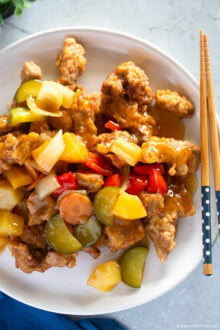Jangjorim is a Korean soy sauce braised beef and egg dish that is savory and hearty. The beef is slightly salty and tender, and the braised quail eggs are a fun bonus. Try it today to add some savory deliciousness to your next Korean meal!
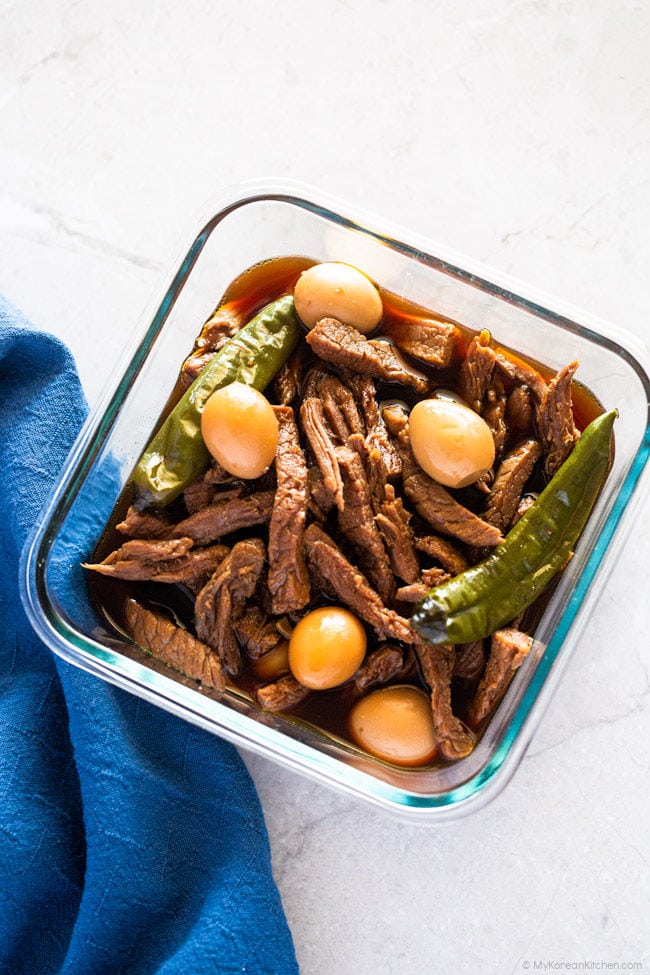
What is Jangjorim
Jangjorim (장조림) is a Korean dish consisting of soy sauce braised beef and often boiled eggs or quail eggs. It is traditionally made with beef, but you can also use pork.
It is a popular banchan (side dish) that is often served with a bowl of rice. The beef is simmered in a soy sauce based marinade, resulting in a sweet, salty and savory dish that is perfect for any occasion.
My Best Cooking Tips
Cut of Meat
There are many cuts of beef that can be used for jangjorim, depending on what you have available or what your preferences are. Some common cuts include eye round, brisket, flank steak, and shank as they are less expensive than other premium cuts.
The cooking time may vary depending on the cut of meat, so make sure to allow some room for variance before starting to cook. Additionally, some cuts of beef need to be sliced thinly while others can easily be shredded by hand.
If you’re using pork, leaner options like pork loin or tenderloin are good choices if you want to avoid fat.
Eggs or No Eggs
Many Koreans use either hard boiled quail eggs or chicken eggs when making jangjorim. Quail eggs are a popular ingredient in Korea and are easy to find; you can even buy them pre-peeled, which saves a lot of time. Peeled quail eggs can be found in a plastic sealed bag or in a tin.
I haven’t seen Korean brand peeled quail eggs in my area yet, but I’ve seen tinned quail eggs at a Korean grocer. These are from Thailand and they come soaked in water or brine; you will need to drain and rinse them before use.
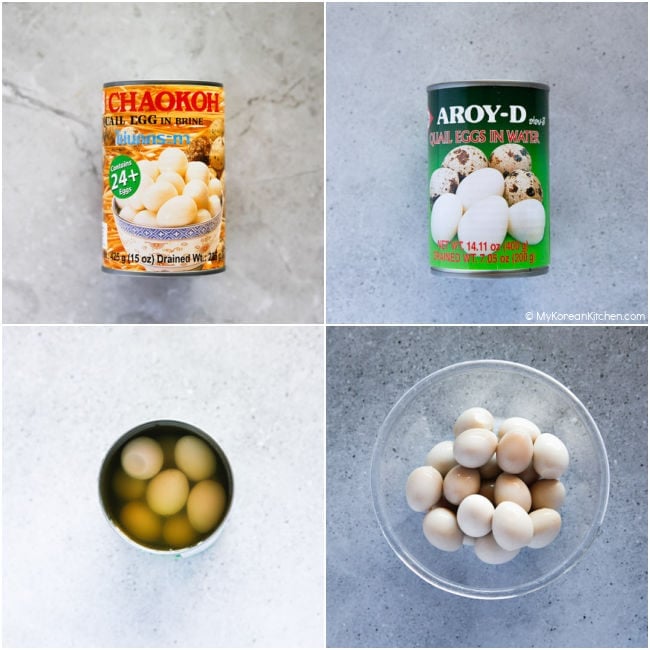
Chilies or No Chilies
While it’s optional, many Koreans like adding some shishito peppers to jangjorim for a bit of chili flavor without too much heat. These peppers are milder in flavor, and can add a unique taste without being too spicy. They also have a sweet taste with an earthy, smoky flavor.
If shishito peppers are not available, then padron, jalapeño, or cayenne pepper can be used instead. Keep in mind that the spice level will be different.
Fat
You may notice some oil floating to the top of the sauce when it is chilled. However, this doesn’t affect the taste.
If you want to minimize this from happening, you can put the sauce after braising the meat in the freezer for a few hours. The oil will separate and float to the top, and you can spoon it off. Another option is to reheat the jangjorim just before serving, which will melt the fat back into the dish.
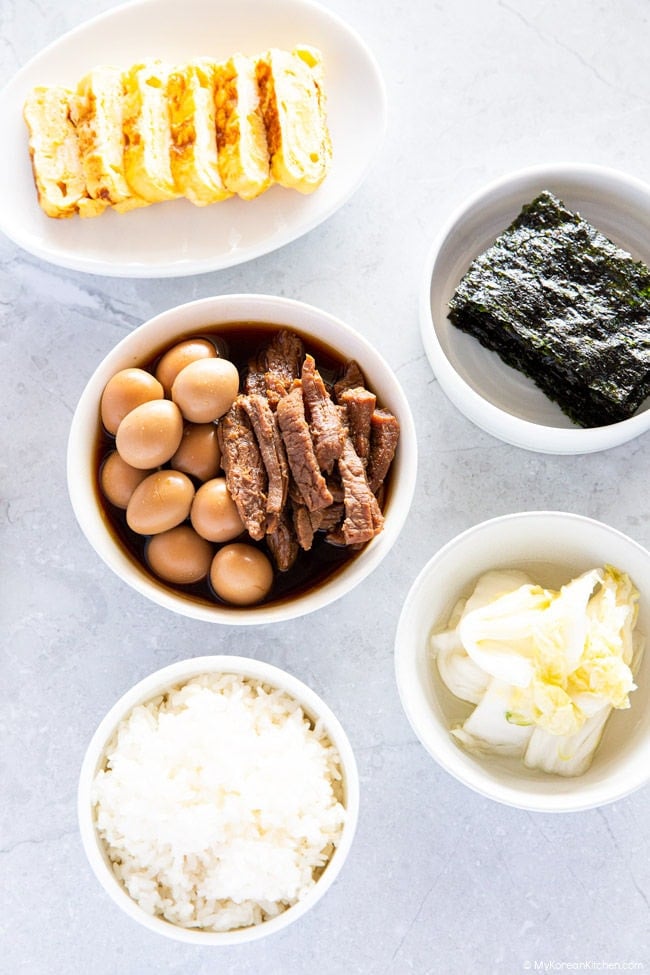
What To Eat with Jangjorim
Jangjorim has a slightly salty and sweet taste, so a plain bowl of rice is all you need to make a quick meal.
Of course, you can also add other Korean side dishes to make it more elaborate. Some examples of such dishes include Kimchi, Korean Egg Rolls, Seasoned Seaweed, Spicy Korean Dried Squid.
You can also serve with Korean soup or stew, such as Bean Sprout Soup and Doenjang Jjigae. These soups and stews are hearty and filling, and can really round out a meal. Just thinking about all these different combinations makes me hungry!
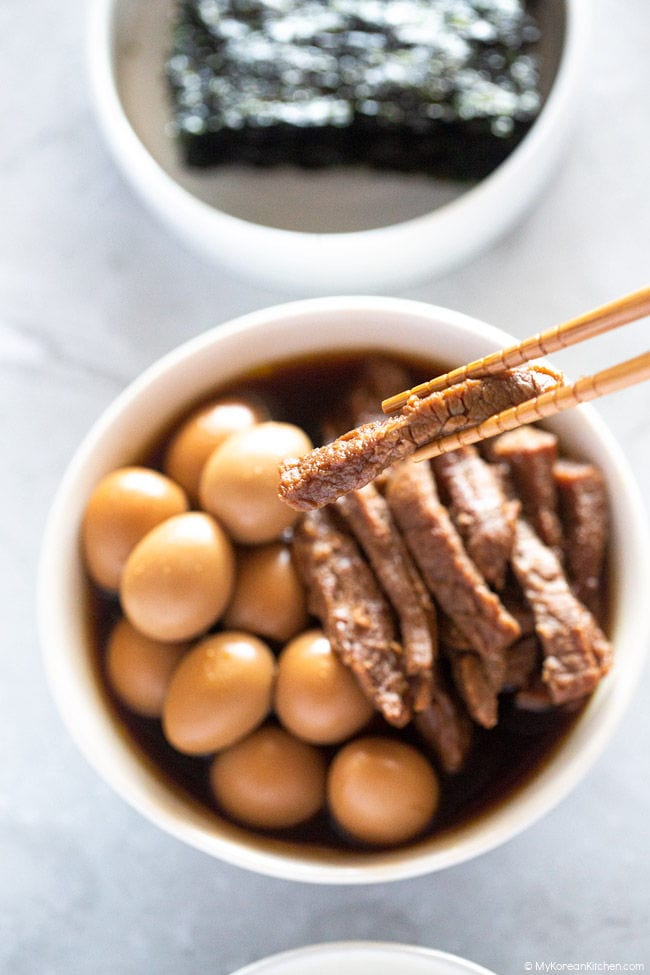
How To Store
Jangjorim can be served either cold or warm, though it is typically eaten cold. It is best eaten within three days of being made, but it can last up to one week when refrigerated in an airtight container.
If you make a large batch, you can portion and freeze it for later use. Jangjorim will last for up to three months in the freezer.
Other Korean Side Dishes You Might Like
I love braised dishes because they bring out so much depth of flavor. If you’re like me, here are some of my braised Korean side dishes. I hope you enjoy them as much as I do.
- Soy Sauce Eggs (Gyeran Jorim, 계란조림)
- Korean Braised Potatoes (Gama Jorim, 감자조림)
- Korean Braised Short Ribs (Galbi Jjim, 갈비찜)
- Braised Kimchi (Kimchi Jjim, 김치찜)

Ingredients for Jangjorim
Meat
- 600g / 1.3 pounds beef – eye round, brisket, flank steak, or shank – if the cut is too thick, cut it in 2 to 3 pieces
- 200g / 7 ounces quail eggs, or 4 chicken eggs, hard boiled, peeled and cleaned
Broth
- 4 cups water
- 2 Tbsp rice wine, sweet (mirin)
- 130g / 4.6 ounces onion, peeled and cut into quadrant chunks
- 15g, 0.5 ounces green onion, white part
- 10g / 0.4 ounces ginger, peeled and rinsed
- 1 tsp whole black pepper
- 1 tsp fine sea salt
Sauce
- 1/3 cup & 2 Tbsp soy sauce, regular (I use kikkoman brand)
- 1/4 cup brown sugar
- 1 to 2 green chili or shishito pepper
*1 Tbsp = 15 ml, 1 cup = 250 ml
How to Make Jangjorim
1. Soak the beef in cold water for about 30 minutes to draw out the redness (myoglobin) on the meat.

2. Put the beef and broth ingredients into a medium-sized pot. Boil it for about 15 minutes on medium-high heat without the lid on. This helps to evaporate the gamey smell from the meat. While boiling, scoop out any bubbles that form in the pot and discard them.
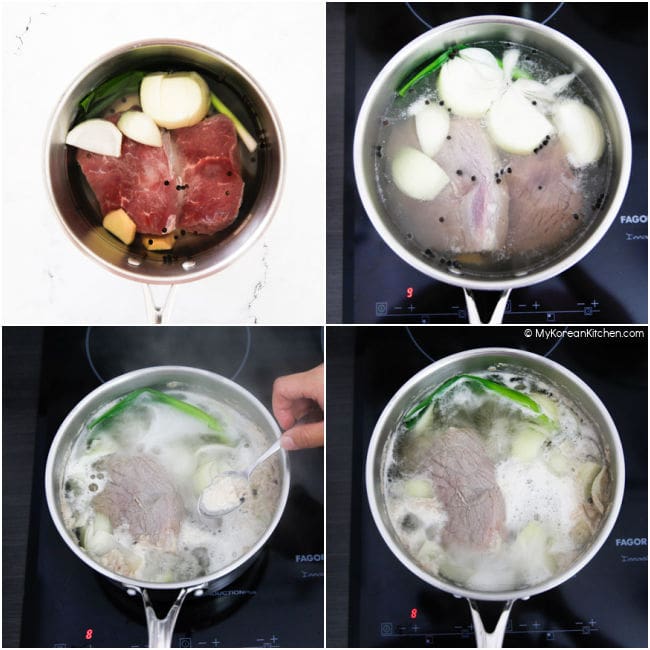
3. Sieve the boiled water (broth) over a bowl or pot, reserving about 3 cups of broth and the beef. Discard the rest of the aromatic vegetables.

4. Cool down the beef for 5 to 10 minutes so it will be easier to handle. You can cut the meat into strips by following the muscle lines with your fingers, or for more even pieces, cut it into index finger-length (6-7 cm / 2.5 inch) strips that are 1 cm / 0.4 inch in width. The traditional method is to tear the beef with your hands, but I prefer cutting with a knife.
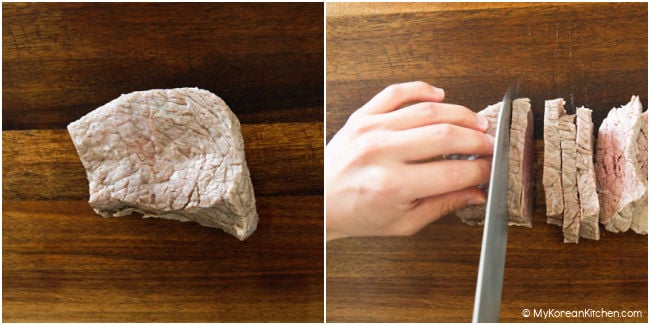
5. Place the 3 cups of broth in a clean pot. Then, add the soy sauce and sugar. Boil the pot on medium-high heat with a lid on.
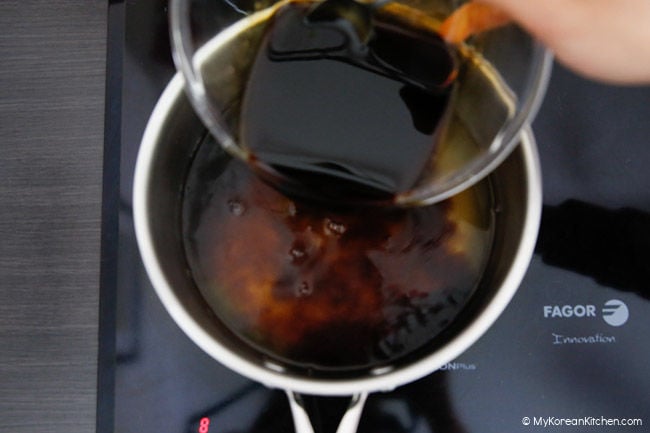
6. When the sauce starts to boil, add the beef, quail eggs, and green chilies. Boil them on medium heat without a lid on for 30 minutes. Remove from the heat.
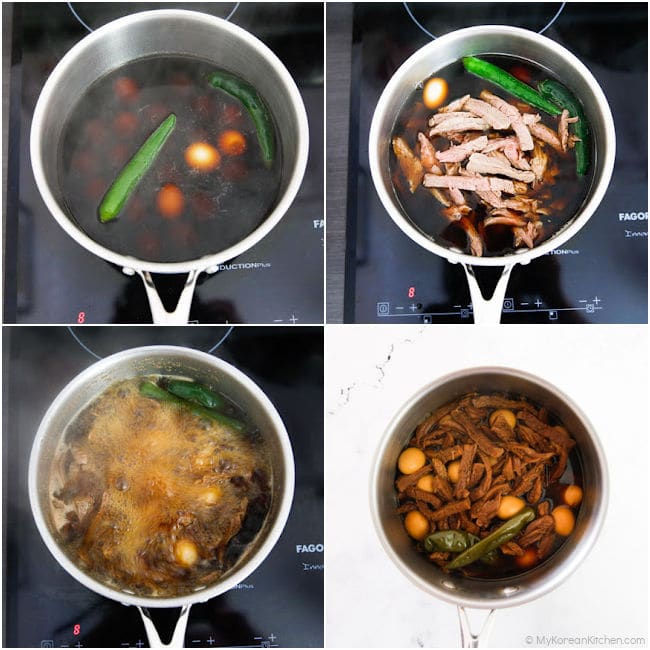
7. Transfer the beef, quail eggs, and chili into a glass container. Pour the sauce into the container. To serve, dish out a small portion of meat and quail eggs in a serving bowl and serve with a bowl of rice and other Korean side dishes.
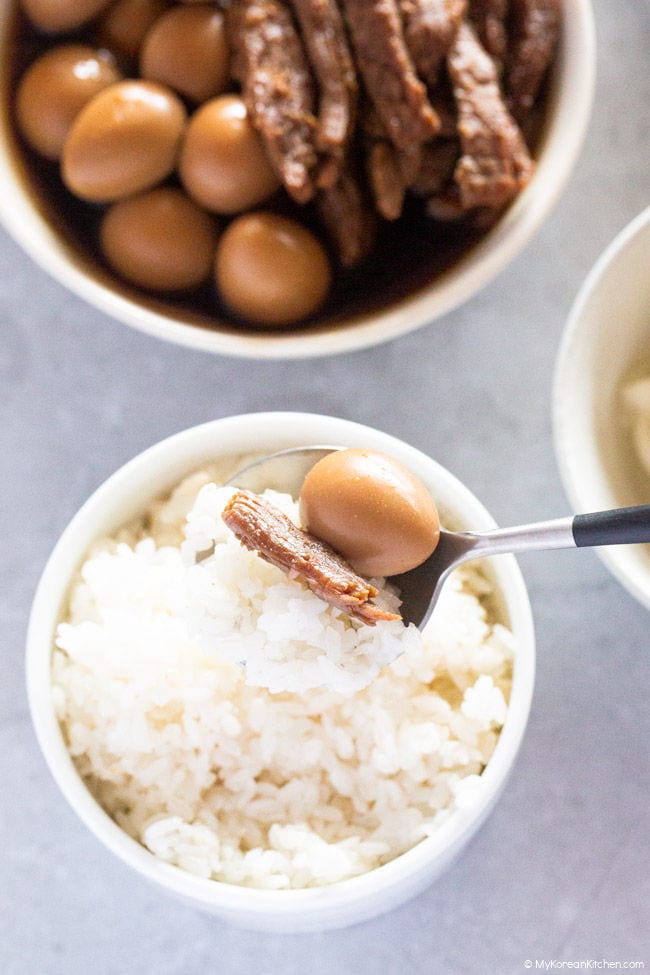
Love Korean food? Browse lots more Korean recipes from my easy Korean recipe collections. And subscribe to my newsletter for all of the latest updates including new recipes, what MKK communities are cooking and K-Dramas!
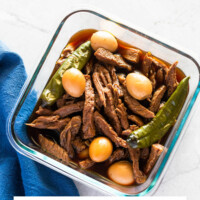
Jangjorim (Soy Sauce Beef and Quail Eggs)
Ingredients
MEAT
- 600 g beef - eye round, brisket, flank steak, or shank (1.3 pounds)
- 200 g quail egg (7 ounces) or 4 chicken eggs, hard boiled, peeled and cleaned
BROTH
- 4 cups water
- 2 Tbsp rice wine , sweet (mirin)
- 130 g onion (4.6 ounces), peeled and cut into quadrant chunks
- 15 g green onion (0.5 ounces), white part
- 10 g ginger (0.4 ounces), peeled and rinsed
- 1 tsp whole black pepper
- 1 tsp fine sea salt
SAUCE
- 110 ml soy sauce , regular (I use kikkoman brand), 1/3 cup & 2 Tbsp
- 1/4 cups brown sugar
- 1-2 green chili or shishito pepper
Instructions
- Soak the beef in cold water for about 30 minutes to draw out the redness (myoglobin) on the meat.
- Put the beef and broth ingredients into a medium-sized pot. Boil it for about 15 minutes on medium-high heat without the lid on. This helps to evaporate the gamey smell from the meat. While boiling, scoop out any bubbles that form in the pot and discard them.
- Sieve the boiled water (broth) over a bowl or pot, reserving about 3 cups of broth and the beef. Discard the rest of the aromatic vegetables.
- Cool down the beef for 5 to 10 minutes so it will be easier to handle. You can cut the meat into strips by following the muscle lines with your fingers, or for more even pieces, cut it into index finger-length (6-7 cm / 2.5 inch) strips that are 1 cm / 0.4 inch in width. The traditional method is to tear the beef with your hands, but I prefer cutting with a knife.
- Place the 3 cups of broth in a clean pot. Then, add the soy sauce and sugar. Boil the pot on medium-high heat with a lid on.
- When the sauce starts to boil, add the beef, quail eggs, and green chilies. Boil them on medium heat without a lid on for 30 minutes. Remove from the heat.
- Transfer the beef, quail eggs, and chili into a glass container. Pour the sauce into the container. To serve, dish out a small portion of meat and quail eggs in a serving bowl and serve with a bowl of rice and other Korean side dishes.
Notes
- 1 Tbsp = 15 ml, 1 cup = 250 ml
- Jangjorim can be served either cold or warm. It is best eaten within three days of being made, but it can last up to one week when refrigerated in an airtight container.
Nutrition Info (per serving)
The nutrition information shown is an estimate provided by an online nutrition calculator. It should not be considered a substitute for a professional nutritionist’s advice.


